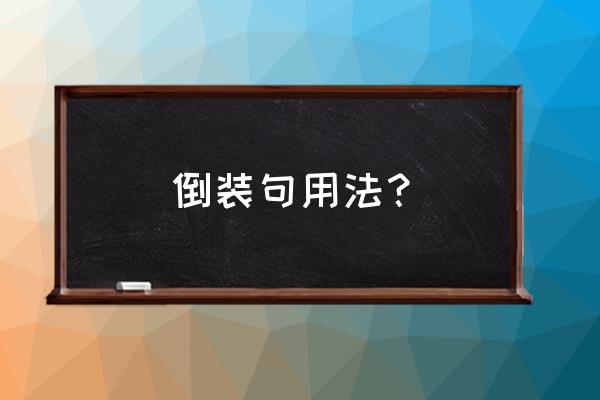倒装句的常见用法

倒装句用法?
倒装句用法?
1、在以here , there , in , out , up , down , away , back , now , then等副词开头的句子里,如果主语是名词,常用全部倒装。 若代词作主语,只把该副词提前主谓语序不变。
2、当句首状语是表示地点的介词词组时,也常常引起全部倒装。
3、以带有否定意义而且修饰全句的词开头的句子,要用“部分倒装”语序(倒装的方法跟变一般疑问句的方法相似)。这类常见词有never,hardly。
倒装句语法?
回答问题:倒装句。所说的倒装句,一般情况下就是主语与谓语颠倒着用——即谓语放到主语的前面。这种用法是为了表达的需要,强调突出一下谓语。例如《国际歌》的第一句“起来,饥寒交迫的奴隶,起来,全世界受苦的人”。“起来”,这个谓语,就放到主语“奴隶”的前面去了。
英语中的倒装句一般怎么用?
英语里的正常语序应该是:主 谓 宾。但是在某些情况下,句子不能用正常语序,要用倒装句。倒装句又分:全部倒装——谓语 主语型;部分倒装—— 助动词\\情态动词 主语 谓语的实义动词型
虽然用的比较少,但是是个很容易丢分的知识点哦
一、全部倒装:通常只用于一般现在时和一般过去时
1. 在there be或者There live(stand, appear, seem, remain, exist….) 句型中
There are two apples on the desk. (原语序:Two apples are there on the desk) 桌上有两个苹果。
There stands a tall man at the gate. (A tall man stands there at the gate) 一个高个男人站在大门口。
2.在“here, there, now, thus, then 动词 主语”的句子中,(谓语动词为be, go, come, lie, run等,主语为名词)Here comes the bus. 巴士来了
Now comes my turn. 到我了。
3.“out\\ in, up\\ down, off\\away, in the distance,on the hill,round the corner”等表示方向性的副词或表示地点的介词词组位于句首,且主语又是名词时,句子全部倒装
Down fell the leaves. 树叶落下了。
Away went the team. 全队都走了。
☆注意:主语必须是名词,非名词则不倒装
Here comes the boy. = Here he comes. 他来了
4.有时为了强调表语,构成“表语 连系动词 主语”结构
Lucky is she who survived the massacre. = She who survived the massacre is lucky. 她能从大屠杀中活下来非常幸运。
5、在某些表示愿望的祝愿语中,全倒装
Long may the Queen reign! 愿女王统治长久!
二、部分倒装
部分倒装是指将谓语的一部分如助动词或情态倒装至主语之前
如果句中的谓语没有助动词或情态动词,则需添加助动词do, does或did,并将其置于主语之前
引导部分倒装的词有:
1. 含有否定或半否定意义的词语:not, never, seldom, hardly, little, scarcely, barely, few…
Never have I heard of him before. = I have never heard of him before. 我从没听说过他。
2. 含有否定结构的连词: not only…but also.., neither..nor.., no sooner, scarely..than.., Hardly had ...when.., not until...nowhere等
Not only can he play tennis, but also I can. 不仅他会打网球,我也会。
3. 表否定意义的介词词组:by no means, in no case\\way, with no method, at no time, on no account, under no circumstances\\condition...
In no way will he betray me. 他绝不会背叛我。
其实还有很多,这里不做详述。